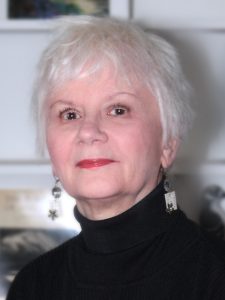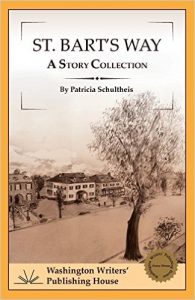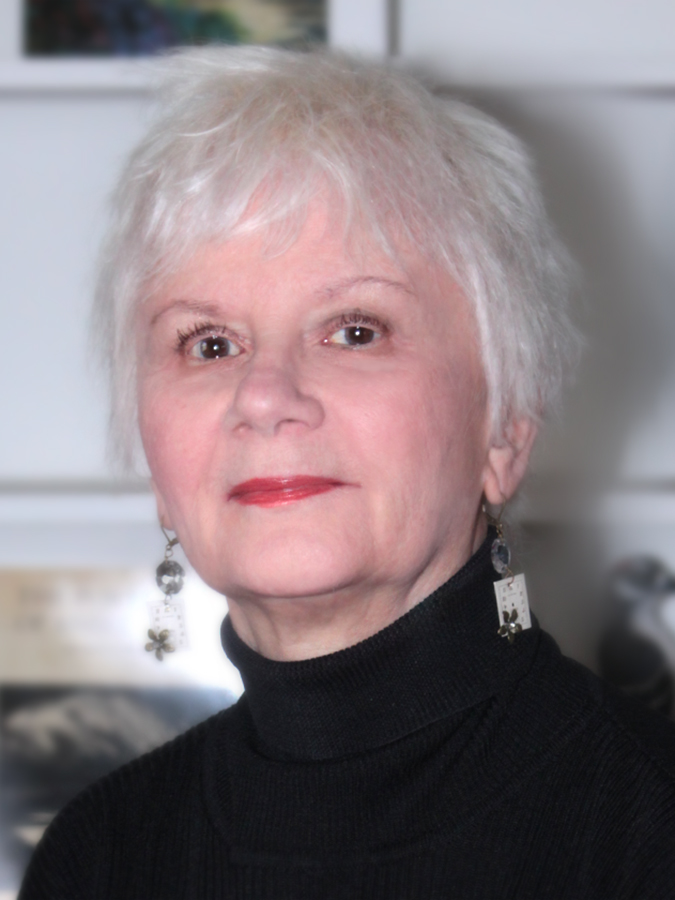INTERVIEW WITH PATRICIA SCHULTHEIS, AUTHOR OF ST. BART’S WAY
One of Patricia Schultheis’s greatest strengths as a writer is her ability to examine relationships between people. She’s also very good at exploring relationships people have with expectations, rules, traditions, and other conventions of life. In her short story collection St. Bart’s Way, which I reviewed here last month, she offers a host of individuals, all trying to understand life and their role in it, particularly as it relates to others. In the interview below, Schultheis talks about how she creates these characters and how they come to inhabit her stories.
to examine relationships between people. She’s also very good at exploring relationships people have with expectations, rules, traditions, and other conventions of life. In her short story collection St. Bart’s Way, which I reviewed here last month, she offers a host of individuals, all trying to understand life and their role in it, particularly as it relates to others. In the interview below, Schultheis talks about how she creates these characters and how they come to inhabit her stories.
Schultheis’s other publications include her pictorial history Baltimore’s Lexington Market and numerous short stories and essays in national and international literary journals.
SW: The characters in St. Bart’s Way are all so richly drawn. Did you begin each story with an understanding of the characters or with an interest in the circumstances?
PS: Thank you for such a kind observation about my characters because I sometimes fear they’re too alike. That became evident to me when I put this collection together and realized that my older women all tended to be somewhat austere and self-castigating. That said, I’m usually intrigued by circumstances and then plug characters in to see how they respond to those circumstances. That was certainly true of “The Assembly,” where Mina’s experience in the Holocaust absolutely informs her present day life. It was also true in “Other Men’s Sons,” where I was interested in exploring the idea of an unforgivable sin, and in “Standards.” Someone in a writing class I once took told me about his brother-in-law who had an affair while his wife was dying. I stored that away for many years and let it ferment before crafting a story around it.
SW: What do you think are the most important elements in creating an authentic character?
PS: The most important thing is to know that character’s internal life. By that I mean how they respond to their circumstances. We all know that it’s completely possible in real life to have people in the same circumstances respond completely differently. The same is true of fictional characters. I think we see that a bit in “The Other Betty,” where the two sisters react so differently to the knowledge of their mother’s lesbian affair. Of course, the task of the writer is to communicate that internal life, to have the character reveal it in ways he may not even be aware of. It’s on that internal plain where a character must be challenged and where he must change, even if his decision is to not change his external circumstances at all.
SW: Did you plan for the stories in St. Bart’s Way to be linked from the beginning or did you see how they fit together after they were written?
PS: No, I absolutely did not plan to write a series of linked stories. Had I, the links might have been stronger. By that I mean the causal relationships between the stories would have been more evident. While I was writing these St. Bart’s Way stories, I also was writing others that also were published as well as essays and book reviews. But whenever I was moved to write a story about middle-class characters, I situated them on St. Bart’s Way, which, incidentally, was St. Bart’s Road in many of these stories as they were first published. Only after each had been published in one literary journal or another did I realize I had a collection. When I submitted the collection to Washington Writers’ Publishing House, I was very concerned about whether or not the order was appropriate. The only thing I was certain of was that “The Haint” should be first, because it establishes the theme undergirding the whole collection, the theme how we blind ourselves to what we in the middle class have gained at the expense of others and of our possible freer selves as well.
SW: Which story is your favorite and why?
PS: That’s like asking a mother which is her favorite child. But, since stories can’t accuse you of sending them into years of therapy, I have to confess that I like “Standards” best. It has a scene where Elise is riding the train home to Baltimore, and I indulged myself in some highly descriptive passages, which I intended to correspond to Elise’s feelings. Of course, one of my best friends, a very smart woman, tells me she always skips over such passages, in which case I at least had the pleasure of writing them. Beyond that, however, I like “Standards” because it posits a moral code free of convention, and the older I get—I’m seventy-two—the more I find that idea intriguing. By conventional standards, the affair of Elise and Charlie is transgressive, at least that’s what my young classmates at Hopkins let me know in no uncertain terms. But, who do Elise and Charlie hurt? No one but themselves, and they’re willing to pay the price. Both Elise and Charlie have had experiences that taught them that nothing is assured. They know that they only have the moment, and, within the limiting circumstances of their affair, they’re free to love each other without any expectations or promises about tomorrow.
SW: Which did you write first?
PS: “After the Service”—aside from a few stories in college, it was the fourth story I had written. I submitted it to Bread Loaf in 1999 and was accepted. The young Turks in the workshop I was in all hated it, except for Leslie Pietrzyk, who ended up writing a blurb for me many years later. I want to say that I am a very slow writer: it takes years for a story to stew around in my brain, and then it has to be nearly perfect on the page. Editors just don’t have the time to fuss. I must have rewritten the opening sentence of “After the Service” forty times. It always sounded stilted, and then, one day, I was staring out my French doors overlooking the Gwynns Falls and heard the narrator’s voice say, “Funny. As a kid I never noticed the azaleas running riot across the back yards of St. Bart’s Way.” I have written variations of the second sentence in that quote many times, but the addition of “Funny” changed the tone. It made it much more intimate. The narrator somehow relaxed and so did I.
SW: Which was the hardest to write and why?
PS: Again, I’d have to say “After the Service,” because I was very new to fiction and really struggled with structure. I still do. After Bread Loaf I knew the story needed serious revision, but it seemed to have so many moving parts. I had a lot of trouble unifying them into a satisfying whole. Also, I really didn’t have a lot of confidence as a writer. And because I didn’t have confidence I didn’t really commit myself. There were weeks when I didn’t write at all. I remember how I dreaded having to write the scene of Pete’s flashback because I didn’t know how to do it. I decided to use fragments and a whole lot of progressive verb forms to capture a sense of confusion and momentum because the action was unfolding so rapidly that the characters didn’t have a chance to process it. My problem was that I didn’t know that I had permission from the Grammar God to use those forms. That’s how insecure I was. When I finally made myself sit down and write that scene it went very easily, and, while that story was rejected many, many times before it was published, no editor ever criticized Pete’s flashback.
SW: In “Standards,” Elise says, “We only love the feelings, not the person. We just love the feelings because we can’t ever really know another person. Not entirely.” Why do you think Elise believes we can’t really know another person?
PS: That sentiment, by the way, is a variation on one expressed by Elizabeth Bowen in her wonderful The Death of the Heart. I keep a journal of words and ideas I’d like to use and hope that putting Elizabeth Bowen’s idea into Elise’s mouth doesn’t make me a plagiarist. If it does, at least I’m an honest plagiarist. But I think the sentiment is true: to truly know another person is impossible. We’re all products of our experiences and how we’ve incorporated those experiences into our consciousnesses. And those processes are unique to each individual. That’s why the sisters in “The Other Betty” react so differently to the knowledge of their mother’s affair with another woman. I’m a widow and sometimes think of how impossible it would be to have a relationship with someone now, the both of us dragging decades of baggage behind us. Neither of us would live long enough to unpack even one suitcase of personal history. On the other hand, there’s love, that sudden, astonishing click, when we apprehend the other as if we’ve known them all our life. That “click” is a great gift none of us is truly worthy of. But once it happens, the delicate work of really getting to know the other person begins.
 SW: The stories in St. Bart’s Way raise issues about relationships. Can a short story fulfill its purpose if it doesn’t raise issues? What do you think is the purpose of a short story?
SW: The stories in St. Bart’s Way raise issues about relationships. Can a short story fulfill its purpose if it doesn’t raise issues? What do you think is the purpose of a short story?
PS: I have an issue with the word “issue.” To me “issue” implies something external, a public policy issue, for instance. It has the connotation of something to be studied, and maybe resolved. I prefer “exploration,” and certainly short stories are explorations of all sorts of things, even of issues. Mine are explorations of relationships: the nature of commitment, the willing embrace of another’s foibles, the recognition that time is short, and the questions of how much we should give and how much hold back. While my characters embark on these explorations in a way that entertains the reader, I also like to think that the questions raised are universal and open ended. I recently led a book discussion group in the Odyssey Program of Johns Hopkins and we read selections of William Trevor’s Cheating at Canasta. Of course, Trevor is a master, and in preparation I read some interviews with him on the nature of the short story. In one, Trevor says that meaning is the inner side of the story. And that meaning is what makes the story matter. I agree: short stories are condensations of reality; they’re reality intensified to the tenth degree. Their purpose is to invite the reader to experience that intensity, and every sentence, every word must contribute to that experience. In that sense, short stories are more like poetry than novels. Novels are such monumental works, that to expect some chapters to be better than others is reasonable. Short stories are allowed no such dispensations.
SW: Your website biography says you didn’t start writing fiction until you were in your early fifties. When did you first think of yourself as a writer and why?
PS: That’s an intriguing question, almost as if you sussed out my insecurities, because I definitely had a lot of trouble claiming the title “writer.” I worked for many years in various public relations jobs and would only identify myself as a writer in conjunction with my job, as in “I’m a writer for the University of Maryland.” The fact that I had had several dozen free-lance newspaper and magazine articles published seemed to have no bearing on my perception of myself. St Bart’s Way is not my first book; it’s my second. In 2007 I wrote Baltimore’s Lexington Market, which was published by Arcadia Publishing, but even after that I was more likely to say “I write” when someone asked me what I did, as opposed to proclaiming “I’m a writer.” Only after St. Bart’s Way was published did I become comfortable stating “I’m a writer.” Somehow I needed the validation of having a bound book with an ISBN number and everything else that goes with professional publishing. Maybe I have a problem with identity . . . my husband had been dead nearly a year before I could say I was a “widow.”
SW: What type of fiction do you read mostly? What are some specific titles that are your favorites?
PS: I’m a very eclectic reader: novels, short stories, memoir, aesthetics, philosophy, I read ’em all. Hell for me would be having nothing to read. My husband was an historian, so much of my library consists of history. Military history, which is very straightforward, especially helps me cleanse my palate after reading a lot of fiction. That said, I genuflect before Jennifer Egan for her wonderful A Visit from the Goon Squad, Donna Tartt for The Goldfinch, Jaimy Gordon for Lord of Misrule, Stewart O’Nan for The Good Wife and Last Night at the Lobster . . . I love O’Nan’s indulgent, forgiving attitude toward human shortcomings. I admire Don DeLillo for just about everything, but especially for Falling Man. The same goes for Alice McDermott. Also, when I’m feeling blue, there’s no place I’d rather escape into than a good mystery. I thank God for Louise Penny and especially for John le Carré who’s akin to Graham Greene for the worlds of moral ambiguity he creates.
SW: As a reader, what makes a story memorable for you?
PS: I read, not as a reader like I once did. Nowadays I mostly read as a writer. By that I mean, I’m looking at the technical craft the writer’s employed to achieve a particular effect. Sometimes, even after studying a passage, how she’s done what she has remains a mystery. I’m thinking of the wonderful opening to Alice Munro’s “The Bear Went Over the Mountain,” which is essentially a long flashback. In writing classes, using a flashback up front is a “no no,” because it impedes the forward motion of the narrative, but Munro is so adroit, her story doesn’t stall at all. Rather it’s enriched and contextualized. Having said that, I enjoy stories tinged with a moral hue or suggesting an unperceived force at work, one which the characters don’t grasp but perhaps sense dimly. I especially love John Cheever’s “The Swimmer.” Read it at your own peril: it tells all you need to know about life.
SW: What do you hope readers remember about St. Bart’s Way?
PS: In a way, this question brings up “The Swimmer” again. The protagonist, Neddy Merrill, lived by certain assumptions about how life should be and of his place in his little world. We all do that, tell ourselves narratives by which we live our lives. We do that as a country . . . we are a freedom-loving nation. And as families . . . Mom loved our brother best. And as individuals . . . I’m a people person or I’m a real klutz. These myths become templates that we play out our lives on. What I hope people take away from my stories, is the realization that occasionally we need to re-examine and re-evaluate these myths. Otherwise they cease to serve as touchstones and instead become shackles.
Sally Whitney
Sally Whitney is the author of When Enemies Offend Thee and Surface and Shadow, available now from Pen-L Publishing, Amazon.com, and Barnesandnoble.com. When Enemies Offend Thee follows a sexual-assault victim who vows to get even on her own when her lack of evidence prevents police from charging the man who attacked her. Surface and Shadow is the story of a woman who risks her marriage and her husband’s career to find out what really happened in a wealthy man’s suspicious death.
Sally’s short stories have appeared in magazines and anthologies, including Best Short Stories from The Saturday Evening Post Great American Fiction Contest 2017, Main Street Rag, Kansas City Voices, Uncertain Promise, Voices from the Porch, New Lines from the Old Line State: An Anthology of Maryland Writers and Grow Old Along With Me—The Best Is Yet to Be, among others. The audio version of Grow Old Along With Me was a Grammy Award finalist in the Spoken Word or Nonmusical Album category. Sally’s stories have also been recognized as a finalist in The Ledge Fiction Competition and semi-finalists in the Syndicated Fiction Project and the Salem College National Literary Awards competition.
- Web |
- More Posts(67)
